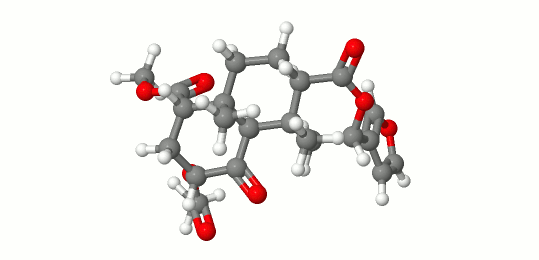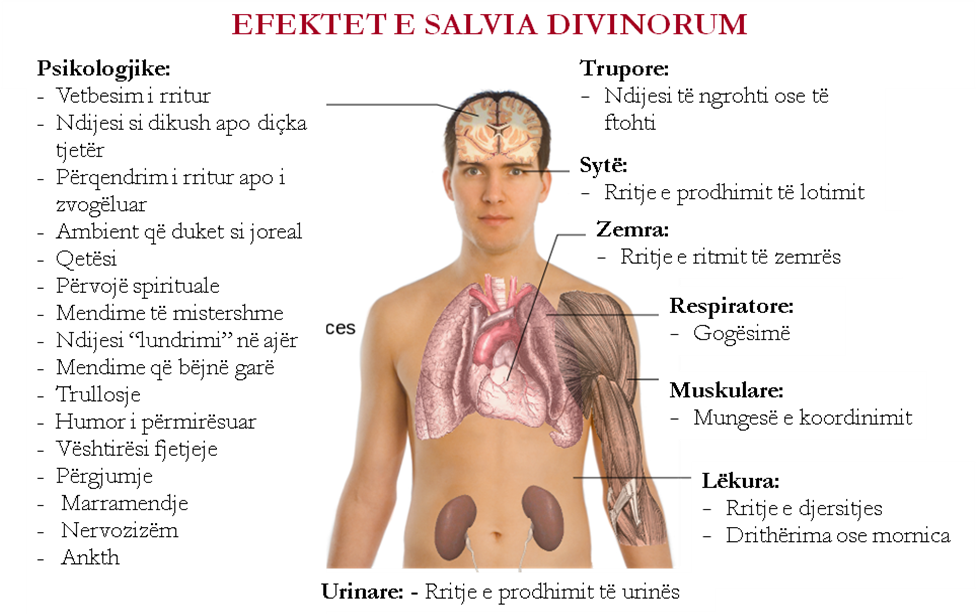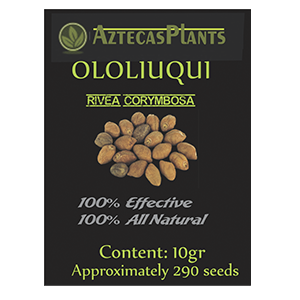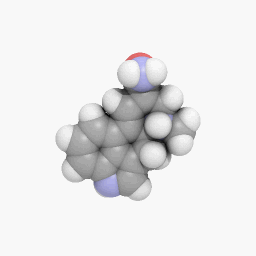Logohu në mjekët.al
NEW PSYCHOACTIVE SUBSTANCES
Over the past few years, through the EU Early Warning System (EWS), five psychoactive plant products have been signaled. The species of plants detected by the system are not subject to international control, but can be controlled by EU member states.
These species are:
- Kava (Piper methysticum)
- Khat (Catha edulis)
- Kratom (Mitragyna speciosa)
- Diviner's sage (Salvia divinorum)
- Silver vine (Argyreia nervosa)
KAVA
Kava, kawa, kava-kava, or kawa-kawa, is a shrub plant originating from the South and Western Pacific. It is known under the name «awa» in Hawaii, «’ava» in Samoa, and «yaqona» in Fiji.
Appearing like pepper, which is confirmed by its taste, its scientific name is Piper methysticum.
Kava has been used since time immemorial in the religious, cultural, and social life of the Pacific islands ensemble. It should not be confused with Kava (Pometia pinnata), a small spherical nourishing fruit, green, of a tree from the sapindaceae family, originating from the Pacific islands.
In the West, Kava is used as a tea to combat symptoms of stress, anxiety, and depression.
In non-homeopathic doses, Kava is more or less prohibited in a number of countries, such as France, due to the risks of acute hepatic infection it may bring.
Also, the use of Kava, whatever the preparation, can lead after a long time to visual disturbances and to a motor discoordination, which can go as far as Parkinson's syndrome.
Kava can be prepared to be chewed, in pill form, or by industrially reducing it to powder.
In principle, Kava does not make you dependent and does not make you accustomed to it.
In the countries of origin, its consumption has become ritualized and regulated by customs. Sharing it is an act of friendship, even a proverb says: «One cannot immediately kill someone with whom we have just drunk Kava».


A more modern preparation became popular due to "Kava bars", also called "nakamal", a term that originally describes a taboo place where men gather around 5:00 PM to consume Kava. In this preparation, the Kava root was dried and then ground into powder and stored. This powder was sometimes mixed with lecithin (a lipid) during preparation before consumption. Dipped in water, the mixture was passed through a blender, then filtered. The pulp in the filter was pressed and then re-dipped several times, before being used. Sometimes, other ingredients such as coconut juice, sugar, soy milk, cocoa, or lemongrass were added to the liquid.
In some tribes, the use of Kava is sacred and forbidden for women.
In some Tanas tribes, women may consume in very special cases, as determined by "Man blo Kustom" (the customary man with bichelamar).
Elsewhere besides the Pacific, Kava is increasingly consumed either with gelatinous capsules or, much more often, in the form of powder bags or boxes, the generic and popular name of which is "Neskava" or "Neskawa". The effects of "Neskava" are much weaker than when the drink is extracted directly from the plant root.
To get an idea of these effects, which are very pleasant, one must therefore buy the roots in the market, mix them with water and consume quickly, without exceeding the measure. Two or three teaspoons or half a coconut shell produce interesting effects. Above six teaspoons, the product becomes a sedative.

Dry Kava reduced to powder before consumption

Refreshing commercialized Kava
KHAT
Khat consists of the fresh leaves of the plant Catha edulis of the family Celastraceae, an evergreen flowering shrub, cultivated in Eastern Africa and in the southwest of the Arabian Peninsula.
There are synonyms: Celastrus edulis - Vahl (1790), Catha inermis - J. F. Gmel (1791).
Common names include: Khat, kat, qat (in French); Khat, qat, kat, Arabian tea, Abyssinian tea, Bushman’s tea (in English); Katyna (in Polish); Mlonge, miraa, murungu (in South African dialects).
Generally, Khat is imported into Europe by air (by airplanes).
The fresh leaves of the plant are chewed for their mild stimulant effects. The leaves have a bitter taste and aromatic smell.





Occasionally, the use of alcoholic solutions (tinctures) of Khat is reported, especially in stores where «herbal highs» are sold, and at music festivals.
The psychoactive constituents of the plant are cathinone and cathine, chemically similar to synthetic drugs such as methcathinone and amphetamine.
From a qualitative standpoint, the pharmacological effects of cathinone are similar to those of amphetamine, although less potent.
Cathinone and cathine are respectively listed in Schedules I and III of the UN Convention on Psychotropic Substances of 1971.
Products of the Catha edulis plant are controlled in many EU member countries like Belgium, Denmark, Germany, Greece, France, Ireland, Italy, Latvia, Lithuania, Poland, Slovenia, Finland, Sweden, Norway, as well as Switzerland.

2-dimensional chemical structure of Cathinone
- Molecular formula: C9H11NO
- Molecular weight: 149.19 g/mol

2-dimensional chemical structure of Cathine
- Molecular formula: C9H13NO
- Molecular weight: 151.21 g/mol

Chemical similarity between cathinone and amphetamine
Cathinone, also known as (S)-2-aminopropiophenone or more officially (S)-2-amino-1-phenyl-1-propanone, is unstable and transforms, a few days after harvesting, into a dimer (3,6-dimethyl-2,5-diphenylpyrazine), therefore Khat must be consumed while it is still fresh.
Cathine (1S, 2S-norpseudoephedrine) is another psychoactive substance that results from the metabolism of cathinone in the grown plant.
Cathinone and cathine are chemical substances closely related to phenethylamines.
Cathinone and cathine are central nervous system (CNS) stimulants.
The concentration of cathinone in plasma reaches its peak 1.5 - 3.5 hours after the start of chewing. The average level in plasma can reach up to 100 mg/ml after chewing 60 g of fresh Khat for an hour.
Cathinone is virtually undetectable in blood after eight hours. The first-pass metabolism of cathinone through the liver results in the formation of norephedrine. Only 2% of cathinone is excreted in urine in its original form as secretion.
The half-life of cathinone elimination is 1.5 +/- 0.8 hours, and that of cathine is 5.2 +/- 3.4 hours.
The euphoric effects of Khat begin after about an hour of chewing.
The effects of Khat include: increased blood pressure and a state of euphoria and exhilaration accompanied by a sense of clarity and increased excitement. The state of euphoria and exhilaration can be followed by depression, nervousness, anorexia, and sleep disorders.
Frequent consumption, in high doses, may cause psychotic reactions.
Gastrointestinal effects include constipation and urinary retention.
Some specific links have been observed between Khat consumption and myocardial infarction, liver failure, and mouth cancer, but in many cases, it is impossible to eliminate some confounding effects that do not show the truth.
Although Khat can be consumed as tea or smoked like tobacco, chewing the plant is the most common method of consumption. The fresh plant material (stem, leaves, and flower buds) is chewed (masticated) and the juice of the masticated material is swallowed, while the residues are spat out.
In general, a person consumes 100 to 200 g of Khat leaves (a wrapped bunch) at a time, and the effects last for several hours.
Khat has also been used as an infusion (tea) of dried leaves.
Except for tobacco, concurrent use with other drugs by Khat consumers, including alcohol, is rare.
Fresh Khat contains about 0.1% cathinone and smaller amounts of cathine.
Although Khat is a heterogeneous plant material, it is normally not adulterated with another substance.
In Yemen and in some countries in East Africa, chewing Khat is a traditional practice.
Khat consumption is sporadically reported in Europe, as a substance of choice among immigrants from Somalia, Ethiopia, Kenya, and Yemen.
Most studies have shown that Khat consumers usually do not consume other psychoactive substances, which distinguishes them from other recreational drug users in Europe (polydrug use).
Khat consumption in Somali communities is also reported in Denmark (about 1,350 users) and in Sweden (2,000-3,000 users).
In the United Kingdom, a bunch of Khat is sold for about 5 EURO, but the price is higher in countries where it is controlled.
EFFECTS OF KHAT

KRATOM
Kratom (Mitragyna speciosa) is a tree, belonging to the Rubiaceae family, and grows in Southeast Asia.
It was first described by the Dutch botanist Pieter Willem Korthals.
From a botanical perspective, the Mitragyna genus is closely related to the Corynanthe, Cinchona, and Uncaria species, having a similar biochemistry to theirs. The plant also belongs to the same family as coffee and the psychoactive plant Psychotria viridis.
Other Mitragyna species have a medicinal use in Africa and are also used for their wood. Its leaves can be chewed, smoked, or prepared for infusion.

Mitragyna speciosa (Kratom) Plant

Mitragyna speciosa (Kratom) Plant

Flower of the Mitragyna speciosa (Kratom) Plant
At low doses, Kratom has stimulant effects.
At higher doses, it has effects similar to opiates and has been used in traditional medicine to alleviate pain and to treat opiate withdrawal syndrome.
The main active agents of the Kratom plant are mitragynine (mitragynine), mitraphylline (mitraphylline), and 7-hydroxymitragynine (7-hydroxymitragynine).
Mitragynine is probably responsible for the analgesic activity of the Kratom plant and allows the easing of opiate withdrawal syndrome.
The plant, mitragynine, and 7-hydroxymitragynine are controlled in Denmark, while Lithuania controls the plant and mitragynine.
Kratom leaves are used for their psychoactive effects in their region of origin and also in other parts of the world. Traditionally, Kratom is chewed in the form of raw, fresh leaves by people in Thailand, especially in the southern part of the peninsula. Kratom is also used in neighboring countries in Southeast Asia, where the plant grows naturally. Often continuously, by workers or laborers seeking an analgesic and stimulant effect.
As it is traditionally used, Kratom is not seen as a drug and there is no shame in using Kratom or discrimination against Kratom users.
In southern Thailand, Kratom has been a part of traditional culture for thousands of years and is common in traditional cultural performances and in agriculture. In southern Thailand, the chewing (mastication) of Kratom generally begins around the age of 25 and many people continue to chew leaves for the rest of their lives. A fresh leaf weighs on average 2 grams. The average number of leaves consumed is between 10 and 60 leaves per day, but even more than this is common. In southern Thailand, in some areas, over 70% of males use Kratom every day.
In other countries, the leaves are often prepared for infusion, which we immediately place over steam to obtain a paste that we can chew.
Kratom is very rarely smoked, although this method has some efficacy.

Kratom "flour", prepared for fusion



Kratom has found therapeutic use in Thai ethnomedicine as a medication against diarrhea, as a treatment for opioid dependence, and, more rarely, to increase the duration of sexual intercourse.
Kratom and its derivatives have been used as a substitute for opium, as well as an aid for managing withdrawal from opium. Kratom also contains alkaloids found in the Uncaria tomentosa (Cat's Claw) plant, which are thought to play a favorable role for the immune system and to reduce blood pressure. Kratom also contains epicatechin, a powerful antioxidant also present in dark chocolate.
Data on the incidence (frequency) and prevalence (spread) of Kratom use are lacking, as physicians, in general, are not familiar with it and the use of Kratom is not detected by typical drug screening analyses. Kratom metabolites can be detected by specialized mass spectrometry analyses.
Until 2011, there have been no formal clinical experiments conducted to study the efficacy and safety of Kratom in treating opioid dependency. The pharmacological effects of Kratom on humans are not well studied. Its metabolic half-life period, protein binding, and elimination characteristics are all unknown.
Kratom acts as a μ-opioid receptor agonist, similar to opiates like morphine, although its effects significantly differ from those of opiates.
Kratom does not appear to have significant negative effects and, in particular, seems not to cause the hypoventilation typical of other opioids.
Side effects associated with chronic use of Kratom include loss of appetite and weight loss, constipation, and darkening of facial skin color.
Chronic use is associated with intestinal confusion. Chronic users have also reported withdrawal symptoms including nervousness, nasal discharge, and diarrhea. Generally, withdrawal is short-lived and mild and can be effectively treated with dihydrocodeine and lofexidine.
The effects of Kratom are:
- Irritation, nervousness
- Vomiting (may be severe and prolonged)
- Nausea (may be severe and prolonged)
- Sweating
- Itching
- Constipation (Constipation)
- Delusion
- Lethargy (Drowsiness)
- Respiratory depression
- Chills
- Aggressive and combative behavior
- Psychotic episodes
- Hallucinations
- Paranoia
SALVIA DIVINORUM
The psychoactive plant Salvia divinorum is a rare member of the mint family (Lamiaceae).
The plant is endemic (native) to a small mountainous region of Oaxaca (Mexico), where the Mazatec Indians consume fresh leaves or leaf-based preparations during magical rituals, in healing rites for diseases, or for medicinal purposes.
This plant is also called Diviner's Sage (Sauge divinatoire in French); Shepherdess's Herb (Hojas de la pastora in Spanish); Maria's Herb (Yerba de Maria in Spanish); Ska Maria Pastora (in the Mazatec language); Pipiltzintzintli (assumed Aztec name); Magic Mint; Lady Sally; Salvia; Sage of the Seers (Sauge des devins in French); Wise Diviner (Wahrsagersalbei in German).
Salvia divinorum is a semi-tropical, vivacious plant. It has large green leaves, a squared, hollow stem, and white flowers adorned with a purple dome and crowned with a white spot. The plant develops a floral stalk that easily reaches a height of one meter.
Salvia divinorum grows in the tropical forests of the eastern Mazatec region of the Sierra Madre in the Oaxaca province, at an elevation from 300 m to 1,800 m. Little known in its origin, it appears that this plant is one of the rarest psychotropics in the wild. Unlike other species of its family, Salvia divinorum rarely produces seeds that germinate. Today, the plant is propagated only by cuttings or shoots.
Salvia divinorum is monoecious, meaning it produces flowers of both sexes on the same plant. This species prefers shade and a moist atmosphere. The plant is not frost-resistant. It can be acclimatized to different lighting and humidity conditions, but changes should be made progressively.


Seeds of the Salvia Divinorum plant


Seeds of the Salvia Divinorum plant

Flower of the Salvia Divinorum plant
Contemporary scientific research on Salvia divinorum began in the 1930s.
Salvia divinorum was first recorded in Western literature in 1939 by Jean Basset Johnson, who was researching the use of hallucinogenic mushrooms in Mexico. He observed that the Mazatec Indians used the leaves of the plant “Hierba Maria” (Maria's Herb) to induce visions.
Robert Gordon Wasson continued the research in the 1950s and confirmed the psychoactivity of Salvia divinorum. Along with Albert Hofmann, the discoverer of LSD, and Roberto G. Weitlaner, he was the first to bring leaf samples to the West. They sent one of these samples to Harvard University in 1962, where they were analyzed by Carl Epling.
It remains unclear how ancient the use of Salvia divinorum among the indigenous inhabitants of Mexico is. It is assumed that the plant was introduced after the conquest of the New World. Evidence supporting this assumption is that the Mazatec Indians do not have an indigenous name for the plant. They use names that refer to Maria or sheep herding (“Hierba Maria” or “Ska Maria Pastora”), while both Christianity and sheep were introduced by the Spanish. Moreover, the Mazatec Indians have a method of consumption that is very inefficient, suggesting that they are not aware of the plant’s significant psychoactive power.
R. Gordon Wasson, and others after him, suggest that Salvia divinorum might be the same plant that the Aztecs called “Pipiltzintzintli” (literally “little noble prince”), a plant that was described by a Spanish author in the 17th century.
In the 1980s, Leander J. Valdés III continued to investigate the history of Salvia divinorum before its “discovery” by Wasson. He assumes that “Pipiltzintzintli” is more likely to be the cannabis plant, rather than Salvia divinorum. Nevertheless, the plant remained unknown until 1990, when Daniel Siebert began his research on the plant.
Nowadays, Salvia divinorum is widely known and sold in many (web) stores, but, there is still much research to be done on the chemistry and effects of the Salvia divinorum plant.
Salvia divinorum contains Salvinorin, mainly Salvinorin A and Salvinorin B. It also contains the following psychoactive parent components: Salvinorin A, Salvinorin F (unknown activity), Salvinorin B, Divinatorin A, Divinatorin D, Divinatorin E, etc. The group of salvinorin compounds (Salvinorin A, Salvinorin B, and Salvinorin C included) is called the terpene group. They are primarily all terpenoids.
Only Salvinorin A appears to be at the origin of the psychotropic effects, so it is often simply called Salvinorin.
Salvinorin A is comparable to synthetic hallucinogens LSD or DOB. (DOB - Di-methoxy-bromo-amphetamine, also known as Brolamfetamine and Bromo-DMA, is a psychedelic drug and an amphetamine analogue.)
SALVINORINA A

2-dimensional chemical structure of Salvinorin A

3-dimensional chemical structure of Salvinorin A
- Molecular formula: C23H28O8
- Molecular weight: 432.47 g/mol
- Physical form: Colorless crystals
- Melting temperature: 242 - 244 °C
- Boiling temperature: 760 °C
Dried leaves, leaf extracts, and pure salvinorin A are stable at room temperature, in the absence of light or air, although there are no systematic studies in this area.
Salvinorin A is unstable in basic solutions and is soluble in conventional organic solvents, i.e., in acetone, acetonitrile, chloroform, dimethyl sulfoxide, and methanol, but is essentially insoluble in hexane and water.
Salvinorin A exerts a fully potent and selective agonist activity at the kappa opioid receptors in the CNS. "Classic" hallucinogens such as psilocybin, LSD, or DOB, which are all of alkaloid nature, interact with serotonin receptors.
In humans, Salvinorin A induces profound, short-duration hallucinations.

Salvinorin crystals, magnified 100 times
Traditionally, the Mazatec Indians would wrap the fresh leaves of the Salvia Divinorum plant in the form of a cigarette (priem), which was then chewed without swallowing, sucking the juice, to increase the absorption of the active ingredient.
Also, fresh leaves can be crushed by hand, or by using a stone block, and can be used to prepare an infusion (tea). At least six leaves are necessary for a noticeable effect, which manifests after about 10 minutes and lasts 45 minutes or more.
For recreational use (for pleasure), the most common method of administration is smoking the dried leaves with a pipe, or using a hookah, causing hallucinations after a minute with a short duration (15 - 20 minutes). Generally, an amount of 0.25 to 0.75 grams of leaves is smoked.
The longest-lasting effect is obtained by chewing the raw leaves in the form of "priem" and the typical doses to produce mild to moderate effects are from 10 to 30 grams of fresh leaves, or 2 to 5 grams of dried leaves.
Application under the tongue of the aqueous ethanol solution, prepared from the leaves, leads to an effect that starts after 5 to 10 minutes and can last up to 2 hours.
The infusion (tea) made by steeping leaves in warm water is relatively ineffective, because salvinorin A degrades easily in the gastrointestinal tract.
Vaporizing the dried leaves or extracts, without burning them requires special equipment and somewhat high temperatures (Salvinorin is released at temperatures around 240 °C) and is not a commonly used method.
Inhaling (sniffing) the vapors of pure Salvinorin A carries significant health risks, as the amount inhaled cannot be controlled. This last method can lead to an "overdose" that manifests in the form of psychotic disturbances.
There are concentrated preparations, extract of the leaves of the plant Salvia divinorum, that can be smoked instead of the natural leaves and have a relative intensity suggested by labels such as 5x, 10x, 15x, 20x, and 40x. 40X means that in 1 gram of the prepared plant powder, the extract of Salvinorin A from 40 grams of the chewed Salvia divinorum plant is taken. Thus, the amount of smoke inhaled is reduced, considering the increased dose of salvinorin, facilitating stronger experiences.



Inhalation (snorting) of equivalent doses from 200 to 500 micrograms of Salvinorin A leads to a loss of control of physical movements (incapacity); silly laughter; vivid, colorful and often strange hallucinations, belonging to a dream or a movie. Time boundaries between the past, the present, and the future disappear, and the user is shifted to an alternative temporal and spatial dimension (spatial-temporal disorders) with the impression of being in many places at the same time.

For higher doses, in particular, it can be a frightening "trip" and can cause severe psychotic disturbances. It has been signaled that this might last several hours after the hallucinations have disappeared.
Secondary effects include fatigue, dizziness, and amnesia.
Most people report that the effects of Salvinorin do not favor sociability. Many experienced users confirm that Salvia divinorum is not a party drug.
Short-term effects have a completely different character from the main experience. Approximately half of the users report pleasant flashes or a pleasant mood disposition that comes after taking the drug.
Salvia divinorum may have potential as a therapy for treating dependence on dangerous stimulants (e.g., amphetamines) and opiates.
The chemical composition of Salvia divinorum leaves depends on the stage of the plant's development and/or the type of preparation. Systematic studies of plants from different collections show that the concentration of Salvinorin A in grown plants is included between 0.89 and 3.7 mg/g dry leaves (which corresponds to an average of 0.245%).

Salvia divinorum and Salvinorin A are not listed in any of the United Nations Conventions on drugs.
Australia was the first to ban Salvia divinorum in 1992. The plant is not controlled in Switzerland and Canada. In France, to date, there is no ban related to Salvia divinorum and, not being classified in the list of narcotics, it can be sold as an ornamental plant or as aromatic. In Belgium, despite the noise made, Salvia divinorum is illegal. It has been so since October 22, 2006. Legislators also added Salvinorin A as an illegal substance and thus amended the royal decree of January 22, 1998, which banned Salvinorin A, an active ingredient that did not exist.
The import of Salvia divinorum is banned in Denmark since August 2003, in Spain since May 2004 (only commerce), in Italy and South Korea since January 2005. Purchasing in Norway (since 2002), in Iceland, in Finland (August 2002) as well as in Estonia (since April 2005) requires a medical prescription. Recently, Salvia divinorum is regulated in the following American states: Delaware, Louisiana, Missouri, Tennessee. Since recent videos showing scenes of Salvia divinorum users on sites like YouTube, some American senators have drafted or already proposed bills related to banning the sale, possession, or cultivation of this plant. This ban now seems to be becoming widespread.
Prices vary from country to country and depend on the type and amount of the product in question. A "snapshot" of online shops conducted at the beginning of 2010 by the EMCDDA showed that prices in the European market for a single fresh Salvia divinorum plant ranged between 7 and 40 EURO. Dried leaves cost between 0.5 EURO (25-gram packet) and 1.4 EURO per gram (1-gram packet).
Also, this snapshot showed that the price of the "Salvia 10X" extract ranged between 15 EURO and 35 EURO per gram on the Internet. "Salvia 6X" was sold starting from approximately 10 EURO per gram. The concentration of Salvia divinorum extracts sold can go up to "60X". These are generally sold starting from 33 EURO per gram.
In European countries, information on the extent of the use of Salvia divinorum and its preparations is limited. In Romania, a 2008 survey of young people aged 15 to 34 living in Bucharest, who frequented places of "pleasure", showed that 0.3% of them had tried Salvia divinorum at least once in their lifetime. In an "online" survey conducted at the end of 2009 with people who frequented nightclubs in Great Britain, 3.2% of respondents admitted that they had consumed Salvia divinorum in the last month, which, with this frequency, ranked this drug 15th in terms of the most regularly used drugs. The prevalence of lifetime users reached 29.2%.
In the USA, the annual national survey on drug use and health (National Survey on Drug Use and Health), conducted in 2006, showed that the consumption of Salvia divinorum in the last 12 months was 0.3% among individuals aged 12 and over; in total, approximately 1.8 million people admitted to having already consumed this drug.
SILVER VINE
The Silver Vine or Forest Rose (also known by the English name Hawaiian baby woodrose), scientifically named Argyreia nervosa is a vine of the Convolvulacé family.
The Silver Vine (Argyreia nervosa) is a vigorous climbing vine. The plant is considered among traditional medicines of "Ayurvedic" medicine (traditional medicine in India) where the plant is used as an aphrodisiac, nerve tonic, in the treatment of diabetes, and arthritis.
The map below shows the regions where the Silver Vine or Forest Rose (Argyreia nervosa) grows:


Argyreia nervosa (Silver Vine)

The flower of the Argyreia nervosa plant (Silver Vine)

The Argyreia nervosa plant (Silver Vine)

The fruits and seeds of the Argyreia nervosa plant (Silver Vine)

The fruits and seeds of the Argyreia nervosa plant (Silver Vine)
The seeds of the plant, found in its fruits, contain psychoactive alkaloids: ergine or LSA (d-lysergic acid amide or simply lysergamide), which is very close to LSD, but also with isoergine and ergometrine.
Ergine is an alkaloid of the Ergoline family, produced by some fungi and naturally occurring in various species of convolvulace plants.
Ergine is primarily found in the fruits of Rivea corymbosa (Ololiuqui), Argyreia nervosa (Hawaiian baby woodrose or Silver Vine), and Ipomoea Violacea (Tlitliltzin or Morning Glory) where it is considered responsible for the psychotropic effect.
RIVEA CORYMBOSA


IPOMOEA VIOLACEA

The traditional use of Morning glory seeds by indigenous Mexicans in the USA was first described by Richard Schultes, in 1941, in a brief report documenting their use since the time of the Aztecs.
A further study was published in 1960, when Don Thomes MacDougall reported that the seeds of the Ipomoea tricolor plant are used as sacraments (holy) by some Zapotec tribes, sometimes together with the seeds of the Rivea corymbosa plant, another species, which has a similar chemical composition, with lysergol instead of ergometrine.
Ergine or LSA was first synthesized by Albert Hofmann during his scientific research on LSD.
Ergine was tested for human activity by Albert Hofmann, testing on himself, in 1947, much earlier than it was recognized as a natural constituent.
It was rediscovered fifteen years later by analyzing ololiuqui.
Intramuscular use of a dose of 500 micrograms leads to an explosive, dreamy state, with an inability to maintain clear thoughts. After a short period of sleep, the effects pass and the normal state is reached within five hours.
According to Hofmann, it is ten times less psychoactive than LSD and the hallucinogenic effect contains a narcotic component.
In 1956, the CIA conducted a study on the psychedelic properties of Ergine in the seeds of the plant Rivea corymbosa, as subproject 22 of the MKULTRA project.

2-dimensional chemical structure of Ergine

3-dimensional chemical structure of Ergine
- Molecular Formula: C16H17N3O [Isomer]
- Molar Mass: 267.3257 ± 0.0149 g/mol
- Melting Point: 242 °C (Decomposition)
- Synonyms: d-lysergic acid amide; d-lysergamide; LSA; LA-111
- Route of Administration: Oral, intramuscular
- Metabolism: Hepatic
- Excretion: Through the kidneys, urinary
Since the psychoactive component of the Silver Vine is ergine (LSA), the seeds (fruits) are generally chewed or sometimes infused (as tea).
Ergine is found in the seeds at a concentration of about 0.3% of the dry weight, and three grains are necessary for a dose.
Users describe hallucinogenic effects, similar to LSD, but less intense and lasting about six hours. The main effect lies in the feeling of well-being, of euphoria.
Some users describe physical pain (cramps, nausea, vomiting) somewhat strong that ultimately convince them not to use this product anymore.
The Silver Vine is considered an entheogen from the descriptions of mystical experiences of some users.
There are preparations in the form of ampoules often sold through the Internet.
Being a psychotropic, the desired effects of the Silver Vine can turn into a «bad trip».
The fact of having schizophrenic family descendants increases the problem of consumption.
